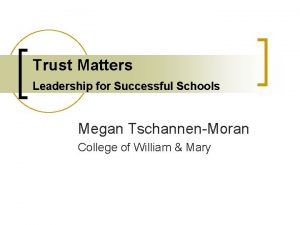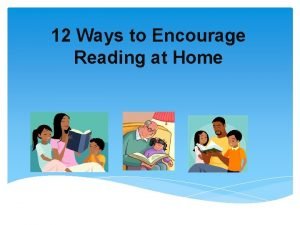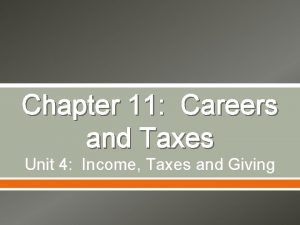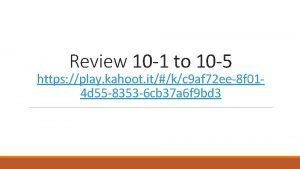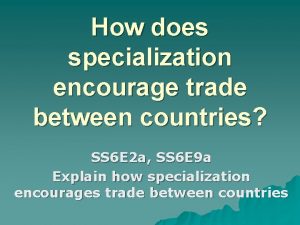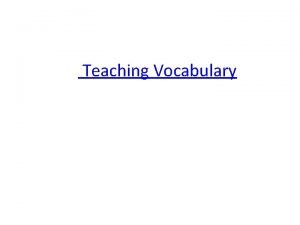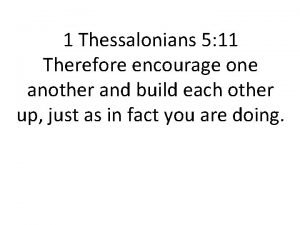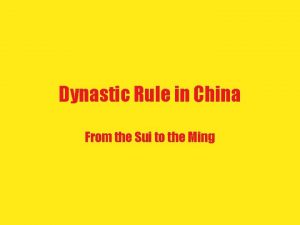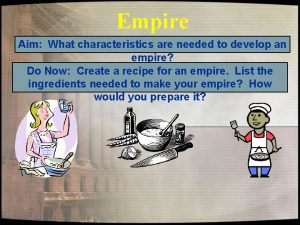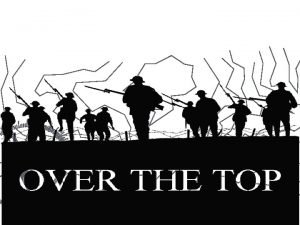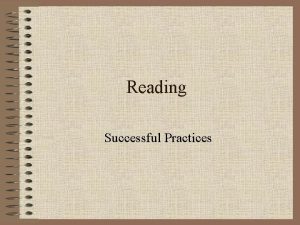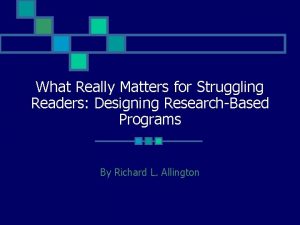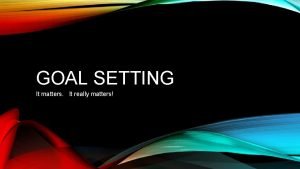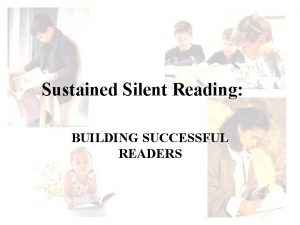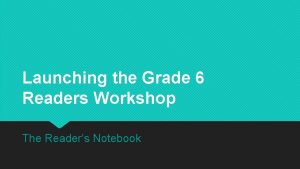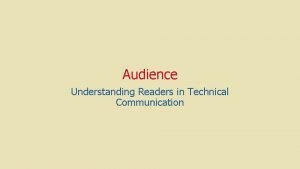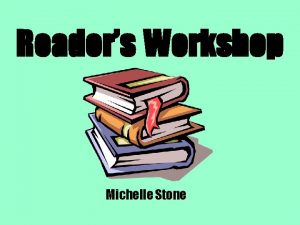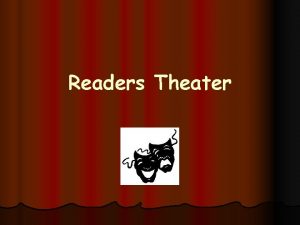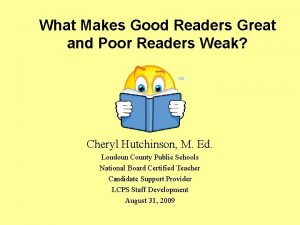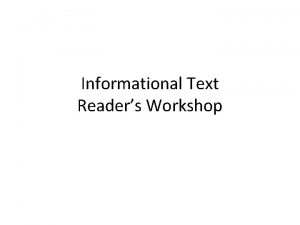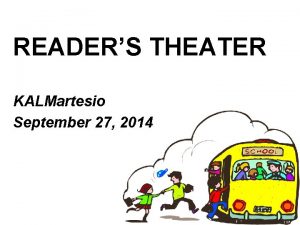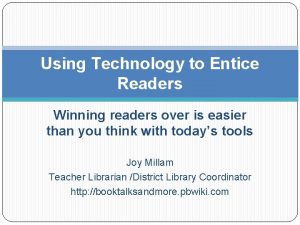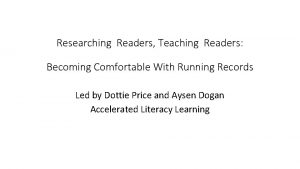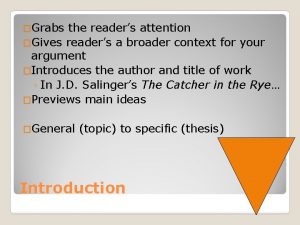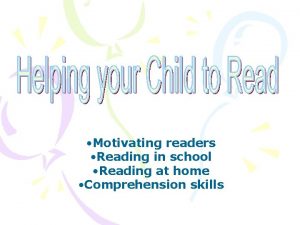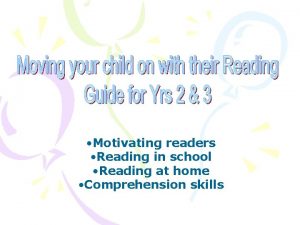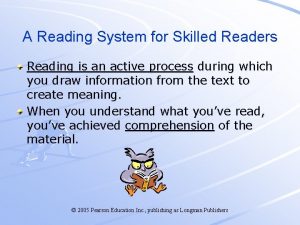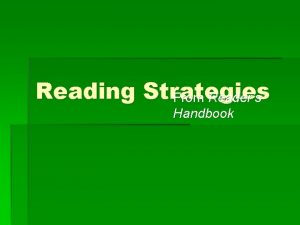Reading Really Matters Practices that encourage successful readers




























- Slides: 28

Reading Really Matters Practices that encourage successful readers Jackie Clark and Linda Bailey October 18, 2013

Introduction and Outcomes �Children who enjoy reading will naturally spend more time reading. � Students who enjoy reading will become more successful readers. �They usually do better in school, score average to above on assessments, and will do better in higher education. �Most children who enjoy reading will grow up to have better opportunities in life.

Share your Favorite Book Pair /Share Activity 1. Count off! 2. Move to the designated area. 3. Share your favorite children’s book. 4. This is my favorite book because…

Where is the Data? According to a 2011 U. S. Department of Education Report 68% of 12 th graders from low SES backgrounds graduated with a diploma in 2008 vs. 91% from nonpoverty backgrounds. Nationally, 25% of college freshmen drop-out. The average student today will have 10 -14 jobs during their lifetime.

Other Factors… Approximately 2/3 of U. S. 3 rd graders are reading below grade level according to NAEP. Research shows that 8/10 students with disabilities have average to above average cognitive ability. (2. 6 of these students have a behavior disability and 4. 2% have an intellectual disability) Consider: What are concerns in your district as it relates to reading?

The Pipeline (Common Core Standards) Year # of Students Level of Completion 1985 3, 800, 000 Kindergarten 1988 2, 810, 000 High School 1998 1, 843, 000 College Freshmen 2002 1, 292, 000 College Graduates 2002 150, 000 STEM majors 2006 1, 200 Ph. D. STEM majors *CCSS and Marilyn Yager Adams-guided reading and speech recognition are keys to good reading instruction.

“ Words mean more than what is set down on paper. It takes the human voice to infuse them with the shades of a deeper meaning. ” ---Maya Angelou

Resources and Researchers � The Daily 5 -( The Sisters-Gail Boushey and Joan Moser)- Focus on learning and motivation. This program fosters literacy and independence. � Sherelle Walker-( CEO of Scientific Learning)- Provides strategies for combining good teaching, content, and effective practices that overcome barriers to learning, thereby closing the achievement gap. � David Sousa-(How The Brain Learns to Read)- Age, experiences, language proficiency, and cultural factors are relevant. � Marcia Tate-(Reading Worksheets Don’t Grow Dendrites)- 20 Instructional Strategies that Engage the Brain. � Eric Jensen-Teaching with Poverty in Mind: What Being Poor Does to Kids’ Brains and What Schools Can Do About It � Professor Richard Milner- Works on Literacy, Language, and Culture. Former Professor Dept. of Teaching & Learning. Vanderbilt University.

If impediments were removed , there would be more engagement, more encouragement, and more success/achievement. - Sherelle Walker

The Daily 5 Literacy Learning & Motivation 5 Literacy Tasks Reading to self Reading with someone Writing Word Work (Vocabulary) Listening to reading

Dinah Zike Reading & Study Skills Foldables �Vocabulary �Interactive lessons & activities �Chapter specific ( Content Area ) �Sentence strips �Concept map

Vocabulary and Summarizing

Concept Maps

Project Board with Tabs

Marcia Tate (Brain-based research) �Growing Dendrites…closing the achievement gap: 20 Instructional Strategies that engage the brain. �Brain-Compatible Strategies: Which will you use to deliver content? Graphic Organizers/ Semantic Maps/Word Webs Humor Manipulatives/Experiments/Labs Models Metaphor/Analogy/Simile Brainstorming/Discussion Drawing/Artwork Field Trips Games Mnemonic Devices Movement Music/Rhythm/Rhyme/Rap Project/ Problem-based Instruction Reciprocal Teaching/Cooperative Learning Role Play/Drama/Pantomime Storytelling Technology Visualization /Guided Imagery Visuals Work Study/Apprenticeships Writing/Journals

Strategies /Activities I Have/ You Have Silent Gallery Walk Elbow Partner Take 5 Quiz-Quiz Trade Morning Meeting or Class Conference 5 W’s Response Cards Note taking Visualization

What’s a teacher to do…? ? ? �Building Blocks for Reading…phonemic awareness; phonics, fluency, vocabulary, comprehension �Struggling readers…how to remediate?

Steps to Effective Reading �Essential Skills (Teaching and Strategies) �Differentiated Instruction based on assessment results �Explicit Instruction �Progress Monitoring �Reteaching �Feedback

Putting Reading First The Research Building Blocks for Teaching Children to Read Phonemic awareness instruction can be taught and learned; helps children learn to read, spell; most effective w/focus on only 1 -2 types of phoneme manipulation Phonics instruction explicit instruction more effective than non-systematic or no phonics instruction; significantly improves K and 1 st gr word recognition and spelling; significantly improves reading comprehension; effective for children from various backgrounds; most effective when introduced early Fluency instruction repeated and monitored oral reading improves reading fluency and overall reading achievement activities for repeated oral reading practice: student-adult reading; choral reading; tape-assisted reading; partner reading; reader’s theatre Vocabulary instruction children learn the meaning of most words indirectly, through everyday experiences with oral and written language; vocabulary instruction should include teaching specific words, extended instruction, repeated exposure, dictionaries, word parts and context clues Text comprehension instruction can be improved with the use of specific comprehension strategies ( monitoring comprehension = checking for understanding, ie: Main Idea Glove, 5 Facts. ; restating the sentence or passage; looking back through the text; using graphic organizers; answering/generating questions; recognizing story structures, cooperative learning

David Sousa ‘How the Brain Learns to Read’ �Phonics should not be taught in isolation; it is good for spelling instruction �Visual processing is important to recognize/master alphabetic concept �The brain of beginning readers analyzes each new word it encounters (it pulls apart and associates letters and sounds) �Best practices include: questioning; summarizing; clarifying; predicting; pre-teaching vocabulary; partner reading; tracking or using page markers; and classroom management �Brainstorm: Why is classroom management important?

Kylene Beers When Kids Can’t Read: What Teachers Can Do �Characteristics of Struggling Readers has few or no strategies for recognizing words; reads haltingly; reads slowly; reads to finish vs. to understand; cannot state the main idea; has limited sight word vocabulary; does not visualize the context; does not predict; does not make inferences; has difficulty recalling information; difficulty spelling; cannot discern reading for information vs. pleasure; avoids reading; says ‘it’s boring and dumb’; stops reading at the sign of difficulty; does not recognize cause/effect; cannot discuss how one genre differs from another; cannot express/explain thoughts �Remediation for struggling readers make classroom expectations clear; establish rapport; give constructive, positive criticism; allow for wait-time; prompting; teach to the child’s strengths; use multi-sensory approach; use scientific-based strategies; learn the child’s history; use buddy system; avoid appeals to ‘try harder’

Kylene Beers… What good readers do? Does teaching strategies mean I have less time to teach content? Example: Developmental Spelling Analysis--Spelling Word Strips, Sentence Strips, Level Readers, Guided Reading, Vocabulary, Paragraphs, Essays, and Stories

Accommodations & Modifications Ways to accommodate… When to modify… � Definition-changes in how a student accesses information & demonstrates learning; instructional level, content or performance not significantly changed. � Examples: � Oral testing � Additional time � Use of computer � Peer support � Highlighting � Underlining �Definition-changes in what a student is expected to learn; the goal –to provide meaningful & productive opportunities to the curriculum & activities. �Examples: �An outline �Word bank �Alternate materials �Peer tutoring

Assessment Tools �Woodcock Johnson �Dibels �Running Records �Informal Assessments �Formative & Summative �Project-based Learning ( w/rubric) �Exit Tickets �Teacher Observations �FBABIP �Student and Parent Surveys �Cumulative File Review �Feedback from Consultations (all stakeholders)

Summing it all up…. What’s a teacher to do? ? ? Instructional Practices, Strategies, Interventions, Accommodations & Modifications � model, model � chunking (divide & teach content; segment) � scaffolding � cooperative learning � small group � 1: 1 � immediate, specific feedback � using background knowledge & relevance � facilitating (walking around, checking for understanding, prompting) � rhyming � sequencing ( before/during/after) � main idea glove � who-what-when-where-why questions ( use graphics; elbow partners) � skim and scan � ‘box-in’ & read the title; trace ; number the paragraphs; stop & think ( identify key points; circle or write key words in margins; read & label words in the questions; prove your answer; mark your answer, R. Payne) � use analogies � teach context clues � highlighting � underlining � exit tickets

Exit Ticket I Learned… I Wonder… I Will Use… Use the index cards on your table. Write your exit ticket responses. Leave your index cards on the table. Thank You!

Reading Matters Resources � � � � � � www. carlscorner. com www. hubbardscupboard www. heidisongs. com www. scientificlearning. com www. tel. com ( Tennessee Electronic Library) www. ccss. org ( or google CCSS) www. ahaprocess. com www. seppub. com ( Shell Education Publishing) Marcia Tate David Sousa Sherelle Walkerhttp: //www. shelleducation. com/professional-development/Kylene Beers Janet Allen The Daily 5 (www. the 2 sisters. com) Dinah Zike ( foldables, & activities for all grades & content areas) Kagan Strategies Lexile Framework for Reading (books, materials for lessons ) Fast For. Word & Jumper. Gym ( helps with sounds; memory; attention, & processing) Marilyn Goodman, Ed. D ( focus to engage children in enjoying , dico 0 verying, & learning) Sally Shaywitz Carol Ann Tomlinson Ruby Payne Marzano Marjorie Frank ( good source for reading & writing) Shaon. Mac. Donald. . om (music bag activities, topic and theme activities)

Experience has taught us that no one mix of instructional strategies and curriculum materials on teaching reading will work for every child. ---David Sousa
 Compare non-critical readers with critical readers.
Compare non-critical readers with critical readers. Trust matters leadership for successful schools
Trust matters leadership for successful schools Ways to encourage reading at home
Ways to encourage reading at home Unit 4 chapter 11 careers and taxes answers
Unit 4 chapter 11 careers and taxes answers Thơ thất ngôn tứ tuyệt đường luật
Thơ thất ngôn tứ tuyệt đường luật Tôn thất thuyết là ai
Tôn thất thuyết là ai Ngoại tâm thu thất chùm đôi
Ngoại tâm thu thất chùm đôi Chiến lược kinh doanh quốc tế của walmart
Chiến lược kinh doanh quốc tế của walmart Gây tê cơ vuông thắt lưng
Gây tê cơ vuông thắt lưng Block nhĩ thất độ 2 mobitz 1
Block nhĩ thất độ 2 mobitz 1 Tìm độ lớn thật của tam giác abc
Tìm độ lớn thật của tam giác abc Sau thất bại ở hồ điển triệt
Sau thất bại ở hồ điển triệt Thể thơ truyền thống
Thể thơ truyền thống Hãy nói thật ít để làm được nhiều
Hãy nói thật ít để làm được nhiều Pre reading while reading and post reading activities
Pre reading while reading and post reading activities Past participle bore
Past participle bore How might specialization encourage trade?
How might specialization encourage trade? Europe faces revolutions
Europe faces revolutions Friends encourage one another
Friends encourage one another Seven principles of developing vocabulary
Seven principles of developing vocabulary Encourage
Encourage Why did gandhi encourage indians to weave their own cloth?
Why did gandhi encourage indians to weave their own cloth? Therefore encourage one another and build each other up
Therefore encourage one another and build each other up Attach 3. hali
Attach 3. hali Dynastic rule
Dynastic rule Types of sales promotion
Types of sales promotion How did darius i encourage unity
How did darius i encourage unity Encourage
Encourage Encourage a person
Encourage a person

